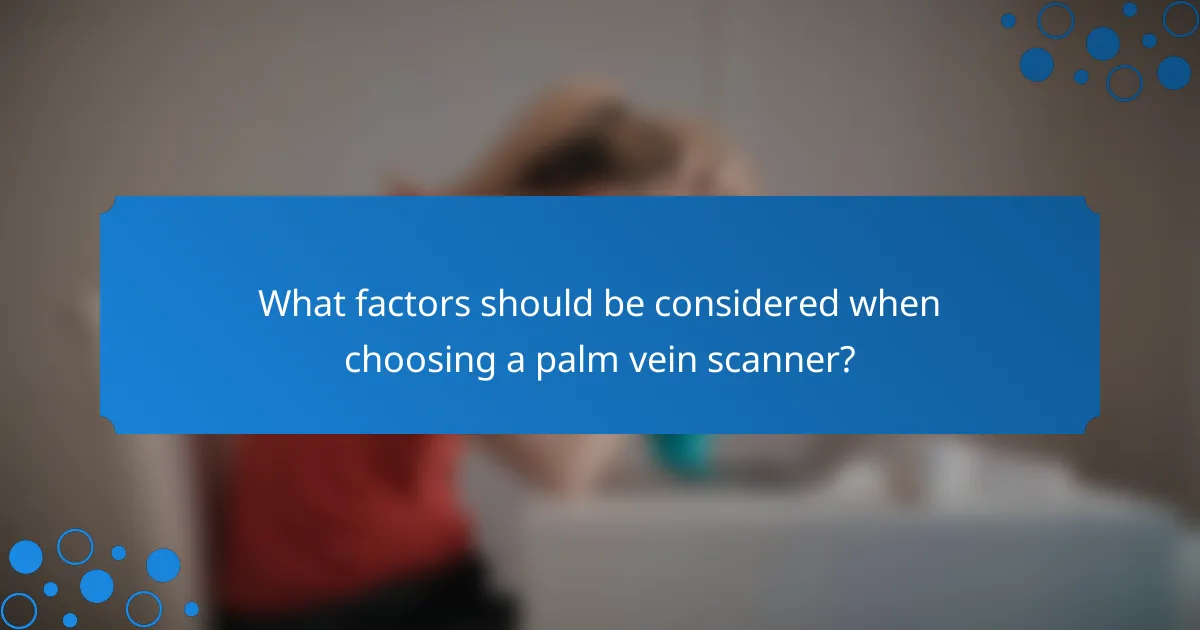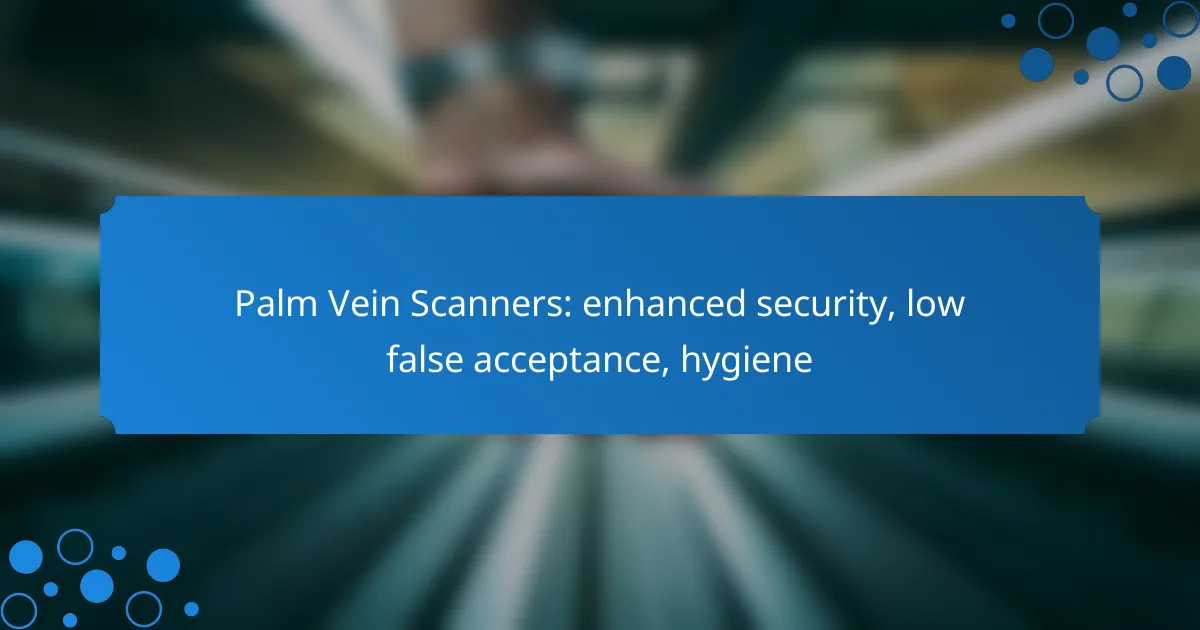Palm vein scanners offer a cutting-edge solution for enhanced security by utilizing unique vein patterns for biometric authentication, making them difficult to forge. With low false acceptance rates, these systems ensure that only authorized users gain access, significantly reducing the risk of unauthorized entry. Additionally, their design promotes hygiene by minimizing direct contact, providing a cleaner and safer experience for users while effectively verifying identity.

How do palm vein scanners enhance security in Canada?
Palm vein scanners enhance security in Canada by providing a reliable biometric authentication method that is difficult to forge. These systems utilize unique vein patterns in an individual’s palm, ensuring that access is granted only to authorized users, significantly reducing the risk of unauthorized entry.
Biometric authentication
Biometric authentication through palm vein scanners relies on the unique patterns of veins within an individual’s palm. This method is more secure than traditional passwords or PINs, as it requires the physical presence of the user. In Canada, organizations can implement these scanners to streamline access control while enhancing security protocols.
Users simply place their palm over the scanner, which captures the vein pattern and matches it against stored data. This process typically takes only a few seconds, making it efficient for high-traffic areas.
Resistance to forgery
Palm vein scanners are highly resistant to forgery due to the complexity of vein patterns, which are unique to each individual. Unlike fingerprints or facial recognition, vein patterns are internal and cannot be easily replicated. This intrinsic quality makes palm vein scanning a robust choice for security applications.
Moreover, attempts to spoof these systems using artificial methods, such as photographs or molds, are generally ineffective. The scanners often include liveness detection features, ensuring that only a real, living hand can be authenticated.
Integration with security systems
Palm vein scanners can be seamlessly integrated into existing security systems, enhancing overall security infrastructure. They can work alongside traditional access control measures, such as key cards or biometric fingerprint readers, to provide multi-factor authentication.
In Canada, businesses and institutions can benefit from this integration by creating a layered security approach. This might involve linking palm vein scanners to alarm systems, surveillance cameras, or visitor management systems, ensuring comprehensive monitoring and control over access points.

What are the benefits of low false acceptance rates?
Low false acceptance rates in palm vein scanners enhance security by ensuring that only authorized users gain access. This accuracy minimizes the risk of unauthorized entry, making it a crucial feature for sensitive environments.
Increased accuracy
Low false acceptance rates indicate that the system is highly accurate in verifying identities. This means that the likelihood of mistakenly granting access to an unauthorized individual is significantly reduced. For instance, a system with a low false acceptance rate may achieve accuracy levels above 99%, ensuring reliable security measures.
High accuracy is achieved through advanced biometric algorithms that analyze unique vein patterns in the palm. These patterns are difficult to replicate, making it challenging for impostors to bypass the system.
Reduced security breaches
With low false acceptance rates, the chances of security breaches are considerably diminished. Organizations can rely on palm vein scanners to protect sensitive information and assets, as the technology effectively identifies and denies access to unauthorized users.
For example, financial institutions and data centers often implement such systems to safeguard against fraud and theft. By reducing the risk of breaches, companies can save on potential losses and maintain their reputation.
Improved user trust
When users know that a security system has low false acceptance rates, their trust in the system increases. This trust is essential for user compliance and acceptance of biometric technologies in various settings, from workplaces to public facilities.
Organizations can foster this trust by communicating the effectiveness of their security measures and demonstrating the reliability of palm vein scanners. As users feel more secure, they are more likely to embrace these technologies, leading to smoother operations and enhanced safety.

How do palm vein scanners maintain hygiene?
Palm vein scanners maintain hygiene by utilizing advanced technology that minimizes direct contact and surface contamination. This ensures a cleaner and safer experience for users while effectively verifying identity through unique vein patterns.
Contactless scanning technology
Contactless scanning technology allows users to authenticate their identity without physically touching the scanner. This reduces the risk of transferring germs and bacteria, making it a hygienic option for public spaces. Users simply place their palm near the scanner, which captures the vein pattern using infrared light.
Minimal surface contamination
Since palm vein scanners do not require direct contact, they significantly reduce the likelihood of surface contamination. This is particularly beneficial in high-traffic areas such as airports, hospitals, and offices where multiple users interact with the same device. The design minimizes the need for frequent cleaning, contributing to overall hygiene.
Easy to clean and maintain
Palm vein scanners are designed for easy cleaning and maintenance, often featuring smooth surfaces that can be wiped down quickly. Regular cleaning with appropriate disinfectants helps maintain hygiene standards, especially in environments where health is a priority. Users should follow the manufacturer’s guidelines for cleaning to ensure longevity and effectiveness of the device.

What factors should be considered when choosing a palm vein scanner?
When selecting a palm vein scanner, key factors include scanning speed, integration capabilities, and cost of ownership. These elements significantly influence the effectiveness and efficiency of the scanner in various applications.
Scanning speed
Scanning speed is crucial for ensuring a smooth user experience, particularly in high-traffic environments. Look for scanners that operate in low tens of milliseconds to minimize wait times. A faster scanner can enhance throughput in settings like airports or offices where quick access is essential.
Consider how scanning speed impacts overall workflow. If users experience delays, it may lead to frustration and reduced efficiency. Aim for a balance between speed and accuracy to maintain security without sacrificing convenience.
Integration capabilities
Integration capabilities determine how well a palm vein scanner can work with existing systems, such as access control or time and attendance software. Ensure the scanner supports standard protocols like Wiegand or OSDP for seamless connectivity. Compatibility with various platforms can enhance its utility across different applications.
Assess whether the scanner can easily integrate with your organization’s current infrastructure. This can save time and resources during implementation. A scanner that offers robust API support can facilitate smoother integration and customization.
Cost of ownership
The cost of ownership encompasses not only the initial purchase price but also maintenance, software updates, and potential training expenses. Evaluate the total cost over the scanner’s expected lifespan to make an informed decision. Lower upfront costs may lead to higher long-term expenses if maintenance is frequent or software is proprietary.
Consider the potential return on investment (ROI) based on improved security and reduced false acceptance rates. A higher-quality scanner may have a higher initial cost but can provide better performance and longevity, ultimately saving money in the long run.

Which industries benefit most from palm vein scanners in Canada?
Palm vein scanners are particularly advantageous in sectors where security and hygiene are paramount. Industries such as healthcare, finance, and government agencies leverage this technology to enhance security measures while minimizing false acceptance rates.
Healthcare facilities
In healthcare settings, palm vein scanners provide secure access to sensitive areas and patient information. They help prevent unauthorized access, ensuring that only verified personnel can enter restricted zones, which is crucial for patient safety and confidentiality.
These scanners also support hygiene protocols, as they require no physical contact, reducing the risk of cross-contamination. Facilities can implement these systems in areas like pharmacies, operating rooms, and patient wards to maintain a sterile environment.
Financial institutions
Financial institutions benefit from palm vein scanners by enhancing security for transactions and account access. This technology significantly reduces the risk of identity theft and fraud, as it relies on unique biometric data that is difficult to replicate.
Moreover, the low false acceptance rate of palm vein scanners ensures that only authorized individuals can access sensitive financial information, which is vital for maintaining customer trust and regulatory compliance.
Government agencies
Government agencies utilize palm vein scanners for secure identification and access control in sensitive areas, such as border control and law enforcement facilities. These scanners help verify identities quickly and accurately, streamlining processes while enhancing security.
Additionally, the non-invasive nature of palm vein scanning aligns with public health initiatives, making it a suitable choice for environments where hygiene is critical. This technology can be integrated into various governmental operations to improve efficiency and security simultaneously.

What are the emerging trends in palm vein scanning technology?
Emerging trends in palm vein scanning technology focus on improving security, reducing false acceptance rates, and enhancing hygiene. These advancements are driven by the integration of artificial intelligence, the development of mobile solutions, and a growing emphasis on contactless identification methods.
AI integration for enhanced security
AI integration in palm vein scanning enhances security by improving the accuracy of biometric recognition. Machine learning algorithms analyze vein patterns more effectively, significantly lowering the chances of false acceptance and ensuring that only authorized users gain access.
Additionally, AI can adapt to environmental changes and user behavior, making the system more robust against spoofing attempts. Regular updates and training of AI models can further strengthen security measures, keeping up with evolving threats.
Mobile palm vein scanning solutions
Mobile palm vein scanning solutions are becoming increasingly popular due to their convenience and flexibility. These portable devices allow for biometric authentication in various settings, from healthcare facilities to retail environments, without the need for bulky equipment.
These mobile solutions typically feature user-friendly interfaces and can integrate with existing security systems. When selecting a mobile palm vein scanner, consider factors such as battery life, scanning speed, and compatibility with other technologies to ensure optimal performance.
